Content
MatLab: Elementary Mathematical Functions
Elementary Mathematical Functions
Trigonometric Functions
Examples
Exponential Functions
Examples
Complex Functions
Examples
Rounding and Remainder Functions
Examples
Discrete Mathematics Functions
Examples
Mathematical Constant Functions
Examples
MatLab: Elementary Mathematical Functions
Major Reference Source: MatLab Verson 7.0
Like common scientific calculators, MatLab package also provides some elementary mathematical functions.
Elementary Mathematical Functions
Besides, the baisc arithmetic function for arithmetic operation, there are some other common mathematical functions for scientific calculaton.
-
Trigonometric Functions
-
Exponential Functions.
-
Complex Functions
-
Rounding and Remainder Functions.
-
Discrete Mathematics Functions
-
Mathematical Constant Functions
Trigonometric Functions
| Function | Description |
|---|---|
| sin(A) | to return the sine of elements of A, in radians. |
| sind(A) | to return the sine of elements of A, in degrees. |
| sinh(A) | to return the hyperbolic sine of elements of A. |
| asin(A) | to return the inverse sine of elements of A. Results in radians. |
| asind(A) | to return the inverse sine of elements of A, Results in degrees. |
| asinh(A) | to return the inverse hyperbolic sine of elements of A. |
| cos(A) | to return the cosine of elements of A, in radians. |
| cosd(A) | to return the cosine of elements of A, in degrees. |
| cosh(A) | to return the hyperbolic cosine of elements of A. |
| acos(A) | to return the inverse cosine of elements of A. Results in radians. |
| acosd(A) | to return the inverse cosine of elements of A, Results in degrees. |
| acosh(A) | to return the inverse hyperbolic cosine of elements of A. |
| tan(A) | to return the tangent of elements of A, in radians. |
| tand(A) | to return the tangent of elements of A, in degrees. |
| tanh(A) | to return the hyperbolic tangent of elements of A. |
| atan(A) | to return the inverse tangent of elements of A. Results in radians. |
| atand(A) | to return the inverse tangent of elements of A, Results in degrees. |
| atanh(A) | to return the inverse hyperbolic tangent of elements of A. |
| sec(A) | to return the secant of elements of A, in radians. |
| secd(A) | to return the secant of elements of A, in degrees. |
| sech(A) | to return the hyperbolic secant of elements of A. |
| asec(A) | to return the inverse secant of elements of A. Results in radians. |
| asecd(A) | to return the inverse secant of elements of A, Results in degrees. |
| asech(A) | to return the inverse hyperbolic secant of elements of A. |
| csc(A) | to return the cosecant of elements of A, in radians. |
| cscd(A) | to return the cosecant of elements of A, in degrees. |
| csch(A) | to return the hyperbolic cosecant of elements of A. |
| acsc(A) | to return the inverse cosecant of elements of A. Results in radians. |
| acscd(A) | to return the inverse cosecant of elements of A, Results in degrees. |
| acsch(A) | to return the inverse hyperbolic cosecant of elements of A. |
| cot(A) | to return the cotangent of elements of A, in radians. |
| cotd(A) | to return the cotangent of elements of A, in degrees. |
| coth(A) | to return the hyperbolic cotangent of elements of A. |
| acot(A) | to return the inverse cotangent of elements of A. Results in radians. |
| acotd(A) | to return the inverse cotangent of elements of A, Results in degrees. |
| acoth(A) | to return the inverse hyperbolic cotangent of elements of A. |
| hypot(A, B) | to return the square root of the sum of squares of elements of A and corresponding elements of B |
Examples
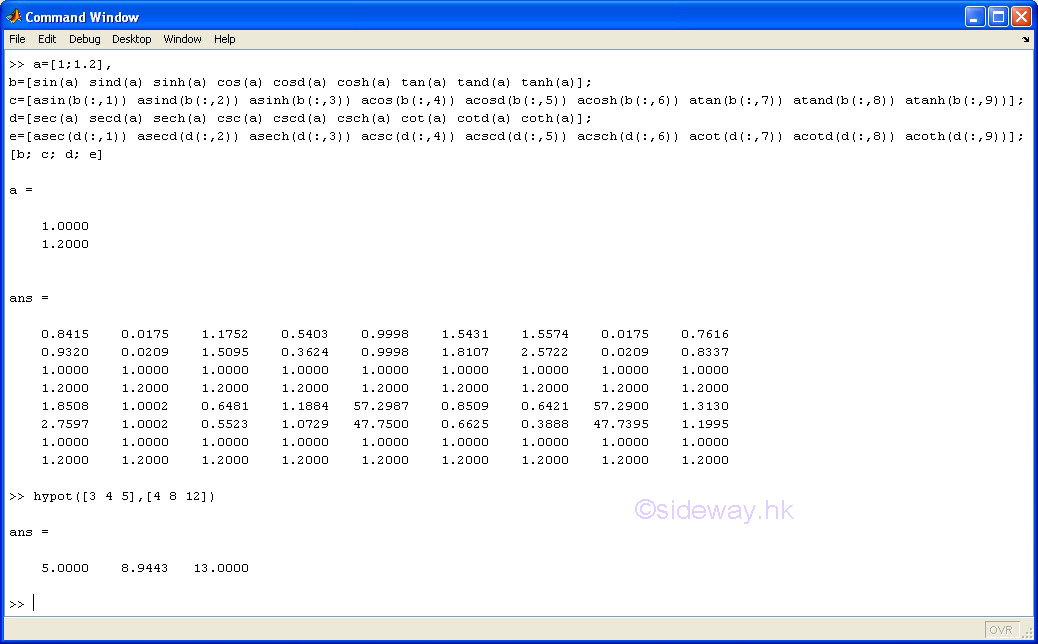
Exponential Functions
| Function | Description |
|---|---|
| exp(A) | to return the exponential of elements of A, i.e. the exponential to the power of A |
| expm1(A) | to return the exp(A)-1 accurately |
| log(A) | to return the natural logarithm of elements of A |
| log1p(A) | to return the log(1+x) accurately |
| log10(A) | to return the common or base 10 logarithm of elements of A |
| log2(A) | to return the base 2 logarithm of elements of A and dissect floating point number. |
| pow2(A) | to return the base 2 to the power of elements of A and scale floating point number |
| realpow(A,B) | to return the base elements of A to the power of the corresponding elements of B. Results must be real. |
| reallog(A) | to return the natural logarithm of elements of A which must be nonnegative real numbers. |
| realsqrt(A) | to return the square root of elements of A. Results must be real. |
| sqrt(A) | to return the square root of elements of A |
| nthroot(A,B) | to return the Bth root of elements of A. Both A and B must be real |
| nextpow2(A) | to return the next higher power of 2 such that 2 to the power of return value is greater than or equal to the absolute value of the number A, or the length of the array A. |
Examples
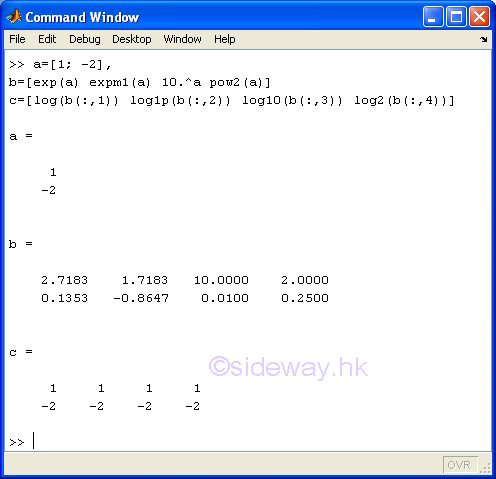
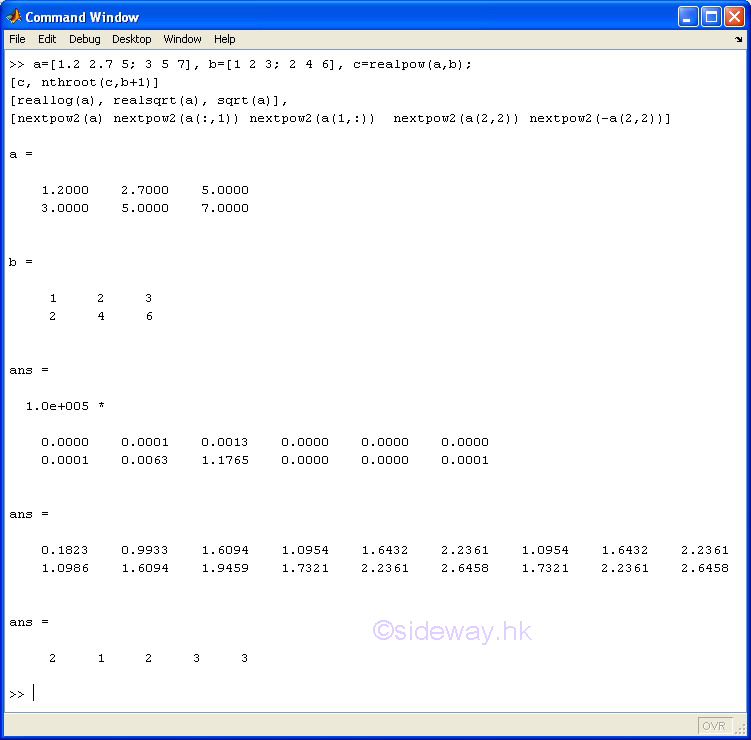
Complex Functions
| Function | Description |
|---|---|
| abs(A) | to return the absolute value of elements of A. Or the complex modulus or magnitude of the complex elements of A |
| angle(A) | to return the phase angle in radians of the complex elements of A |
| complex(A,B) | to return the complex result from A as real part and B as imaginary part. |
| conj(A) | to return the complex conjugate of A |
| imag(A) | to return the complex imaginary part of A |
| real(A) | to return the complex real part of A |
| unwrap(A) | to return a smooth A after correcting or unwrapping radian phase angles of A |
| isreal(A) | to return a true flag, 1, if A is a real array. |
| cplxpair(A) | to return and sort complex numbers into complex conjugate pairs |
Examples
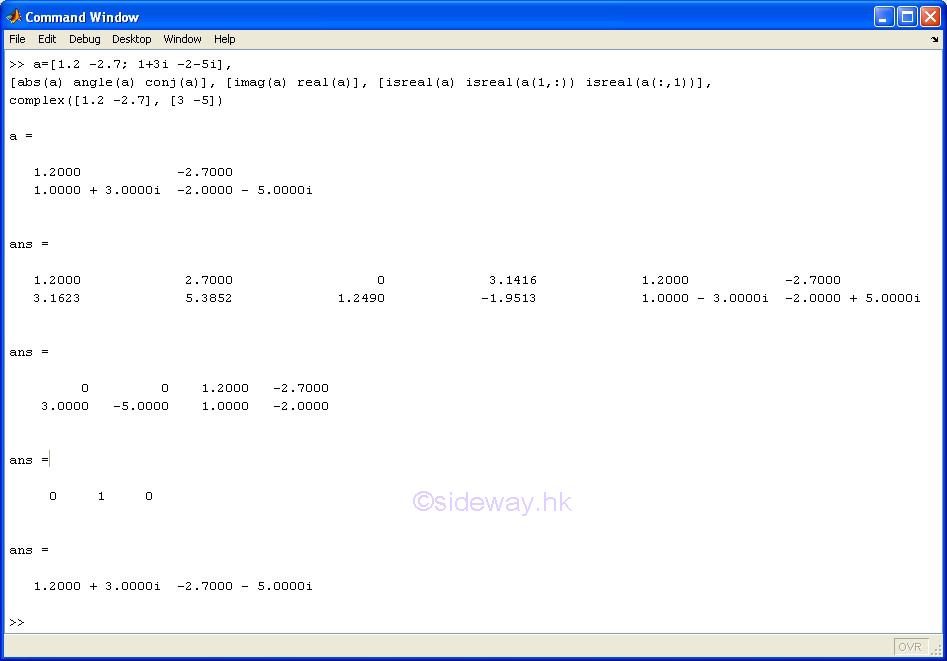
Rounding and Remainder Functions
| Function | Description |
|---|---|
| fix(A) | to return and round A toward zero |
| floor(A) | to return and round A towards minus infinity |
| ceil(A) | to return and round A towards plus infinity |
| round(A) | to return and round A towards nearest integer |
| mod(A,B) | to return the modulus after division of A by B. |
| rem(A,B) | to return the remainder after division of A by B |
| sign(A) | to return the signs of the corresponding element of A |
Examples
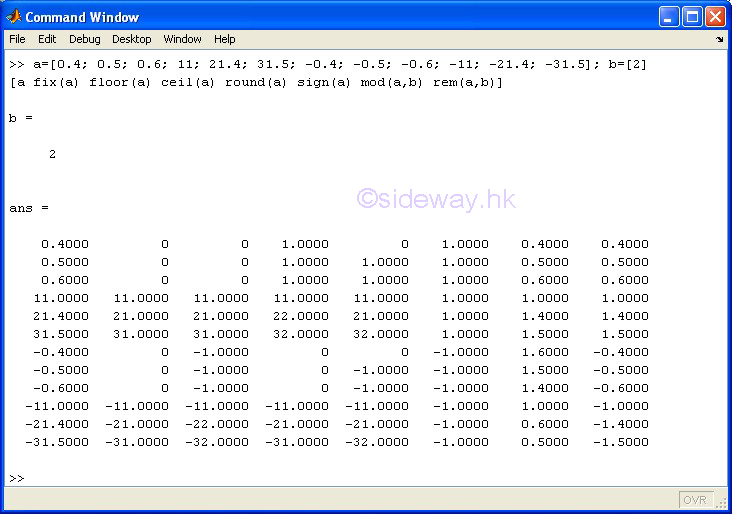
Discrete Mathematics Functions
| Function | Description |
|---|---|
| factor(A) | to return the vector of prime factors of scalar A. |
| factorial(A) | to return the factorial of elements of A |
| gcd(A,B) | to return the greatest common divisor of corresponding elements of A and B. |
| isprime(A) | to return a flag array for elements of A where a true flag, 1, indicates the corresponding element is a prime. |
| lcm(A,B) | to return the least common multiple of corresponding elements of A and B. |
| nchoosek(A,B) | to return the number of combinations of A things taken B at a time for both A and B are non-negative integers or an array of all possible combinations of elements in vector A for taken B a time. |
| perms(A) | to return an array of all possible permutations of elements in vector A. |
| primes(A) | to return a vector for the list of prime numbers less than or equal to scalar A. |
| rat(A,B) | to return the rational fraction approximations of elements of A in terms of the continued fraction according to the specified tolerance B if no output argument is specified. |
| rats(A,B) | to return the rational fraction approximations of elements of A in terms of rational fraction according to the specified length B. |
Examples
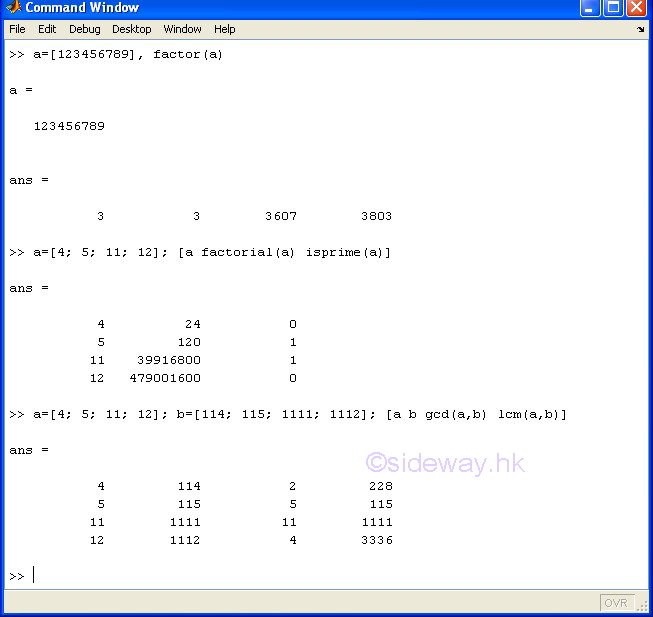
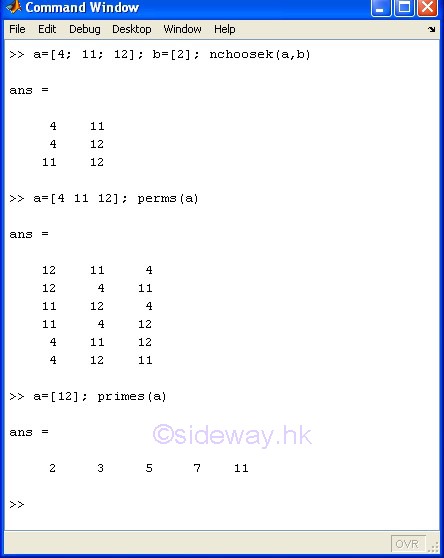
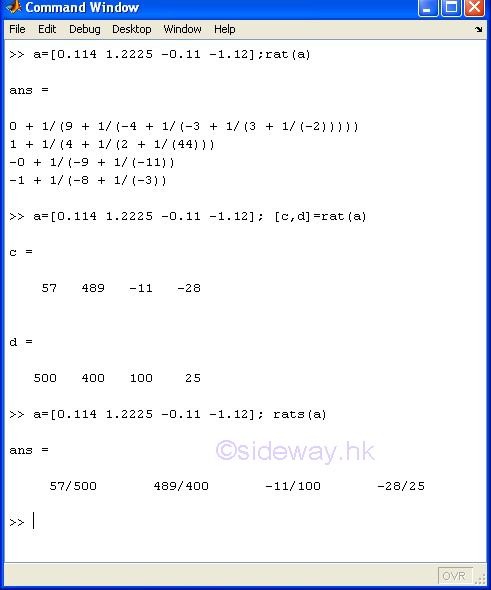
Mathematical Constant Functions
| Function | Description |
|---|---|
| eps(A) | to return the positive distance from abs(A) to the magnitude of next larger floating point number of the same precision as A if A is numberic. A can also be a class name of precision. If A is not specified then the default value of A is 1.0 and the default precision of A is 'double'. |
| i() | to return the system imaginary unit |
| inf(A) | to return an array of infinity with sizes of each dimension specified in vector A |
| intmax(A) | to return the largest positive value in the integer class of class name A where the default class name is 'int32' or '' |
| intmin(A) | to return the smallest negative value in the integer class of class name A where the default class name is 'int32' or '' |
| j() | to return the system imaginary unit |
| NaN(A,B) | to return an array of NaN, Not-a-Number, with sizes of each dimension specified in vector A and class of array specifed by optional B where B must be 'single' or the default 'double'. |
| pi() | to return the floating-point number nearest to the value pi, the ratio of the circumference of a circle to its diameter. |
| realmax(A) | to return the system largest positive floating-point number of class name A where the default class name is 'double' or '' |
| realmin(A) | to return the system smallest positive floating-point number of class name A where the default class name is 'double' or '' |
Examples
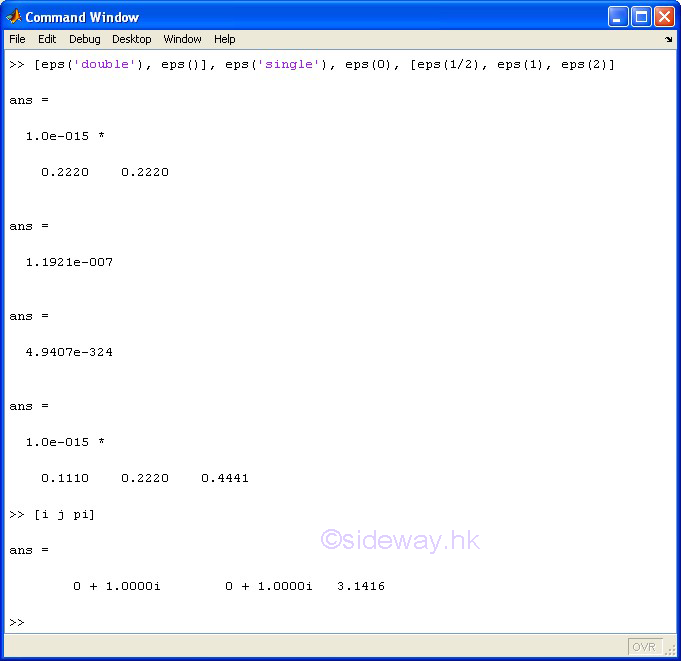
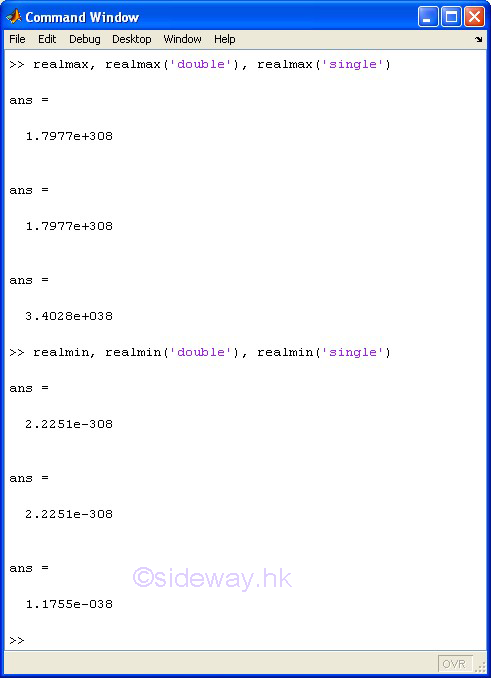
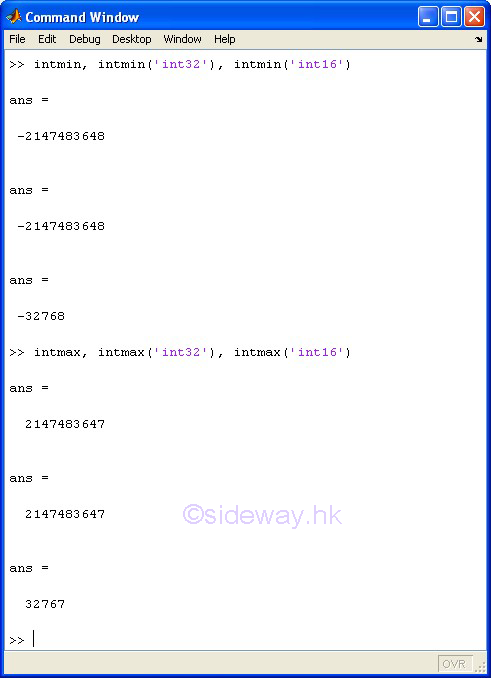
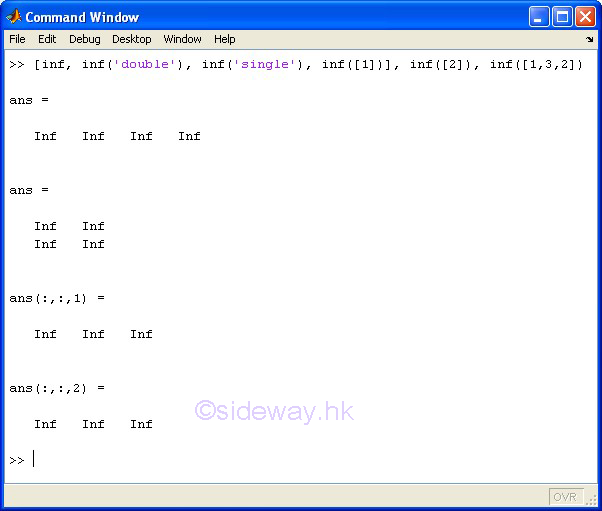
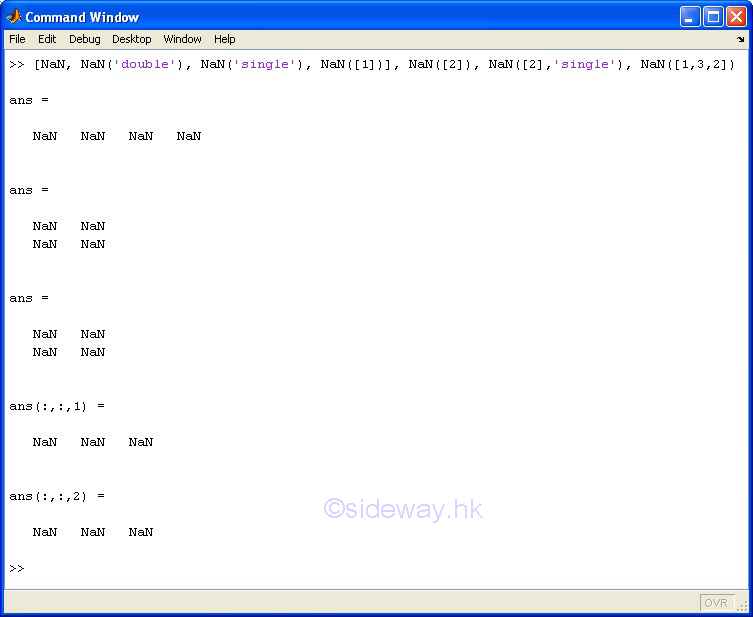
©sideway
ID: 140400004 Last Updated: 4/14/2014 Revision: 1
Latest Updated Links
- Travel Singapore Sight(last updated On 12/6/2025)
- Travel Singapore Rail Network(last updated On 12/5/2025)
- Travel Singapore Things to Know(last updated On 12/4/2025)
- Travel Singapore(last updated On 12/3/2025)
- Legrand Galion(last updated On 12/2/2025)
- Schneider Electric AvatarOn(last updated On 12/1/2025)
- Alfalux(last updated On 11/30/2025)
- Novabell(last updated On 11/29/2025)
- TownGas NJW12RM1(last updated On 11/28/2025)
- SamSung 42" OLED TV S90F 4K(last updated On 11/27/2025)
- Tefal KI7208 GLASS VISION KETTLE(last updated On 11/26/2025)

 Nu Html Checker
Nu Html Checker  53
53  na
na  na
na
Home 5
Business
Management
HBR 3
Information
Recreation
Hobbies 9
Culture
Chinese 1097
English 339
Travel 22
Reference 79
Hardware 54
Computer
Hardware 259
Software
Application 213
Digitization 37
Latex 52
Manim 205
KB 1
Numeric 19
Programming
Web 289
Unicode 504
HTML 66
CSS 65
SVG 46
ASP.NET 270
OS 431
DeskTop 7
Python 72
Knowledge
Mathematics
Formulas 8
Set 1
Logic 1
Algebra 84
Number Theory 206
Trigonometry 31
Geometry 34
Calculus 67
Engineering
Tables 8
Mechanical
Rigid Bodies
Statics 92
Dynamics 37
Fluid 5
Control
Acoustics 19
Natural Sciences
Matter 1
Electric 27
Biology 1
